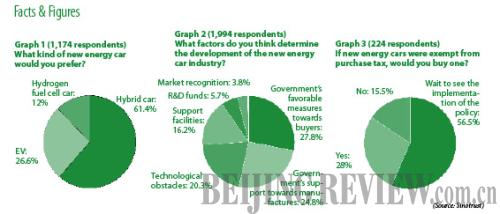|

Sustainability
Although incentive policies play an important role in the EV investment boom, Lang Xuehong, Deputy General Manager in charge of auto sales and marketing consultation at Sinotrust, believes that the government and auto manufacturers both established their strategies based on long-term considerations.
"The fact that fossil fuels will be exhausted someday is undisputed, which means that fuel-saving and environment-friendly new energy cars represent the future of the auto industry," she explained to ChinAfrica.
On June 1, 2010, the Chinese Government officially launched a financial subsidy program targeting private EV buyers in China. It is a move that leads industry insiders to believe the EV's status in China's new energy roadmap is more important than ever.
It seems that new energy automakers in China can already see their final destination. The only question is when, and via which road, can they expect to arrive at the "Promised Land."
"At present, the new energy car market's fate hinges on its cost, support facilities and oil prices," said Zhao Ying, Automotive Industrial Economist at the Chinese Academy of Social Sciences. According to Zhao, the high costs of R&D and manufacturing of EVs, the incomplete construction of electricity charging facilities in China, and fluctuating oil prices comprise the main problems that all EV manufacturers need to consider when they plan for mass production.
Interestingly though, in the eyes of the consumer, the problem is not complicated at all. What they are most concerned about is how preferential will the government's measures be to green car buyers. According to a recent survey conducted by Sinotrust, most Chinese costumers believe that which kind of favorable policies are offered to buyers is the most important factor determining the direction of China's new energy car industry. (Graph 2)
The survey also showed that among the 224 respondents who did not intend to buy a new energy car, 28 percent declared that they would change their mind if the vehicle were exempt from purchase tax; and another 56.5 percent said they would reconsider after taking some time to examine the implementation of such a policy. (Graph 3)
Now government's promotion, manufacturers' investment, and consumers' expectation, all the signs point to the green car industry quietly emerging in China.
However, Lang warned that the mass-industrialization of the EV will be a long process. Big decisions remain to be made. For example, will the EV in China use charging piles or replaceable batteries in the future? And there is still no complete national standards system either.
"Under these circumstances, projects launched too quickly may lead to a waste of resources," she said, adding that by improving start-stop devices, and optimizing the engine assembly and tire management systems, the traditional vehicle also has huge potential in green performance.
According to Lang, the reason that China has decided to develop the new energy car industry and adopt the EV as an important priority is to meet the challenges of environmental pollution and greenhouse gas emissions. In this regard, fully exploring the green potential of traditional cars and concentrating efforts on mass production of EVs after the criteria is determined, might be a better option.
|